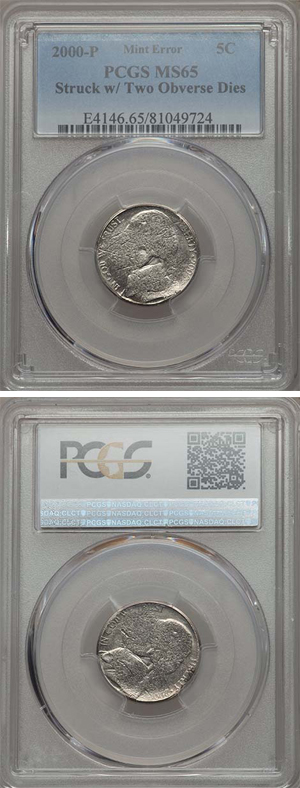How you can tell a rare issue from a novelty coin
“Heads I win, tails you lose…” I can still hear it: Dad teasing us with that riddle when we were kids, as he’d flip a coin. But when it comes to a two-headed (or tailed) novelty coin – who really wins, and who loses?
If you have a two-headed coin, chances are VERY good that it’s a novelty coin (a piece that was likely once legal tender, but has been altered in some way) or magician’s piece. These coins are made by hollowing out the reverse side of one coin, leaving just the obverse design and rim. Then, a second coin of the same type is filed away (usually with a lathe) in thickness and circumference – just enough to snug it inside of the first coin. Voila – to the casual observer, you have a two-headed coin.

The ONLY two-headed Jefferson nickel known to exist was struck at the Philadelphia Mint in 2000! Photos courtesy of mikebyers.com
A surefire way to know the difference
One way to be sure is with the “ring test.” Drop your two-headed coin onto a hard surface. A genuine coin will “ring” when it hits, while a hollowed-out novelty coin will simply land with a thud.
But as we know, there are exceptions to every rule. In this case, they’re very few and far between. The U.S. Mint has procedures in place to make sure that two-headed or -tailed coins are never created. This includes creating die shafts of different sizes and shapes, so that two obverse (or two reverse) dies can’t be paired up in the coin presses.
But… what if someone intentionally messes with the system? In 2016, the collecting community raised its eyebrows when the first known example of a two-headed Jefferson nickel came onto the scene. It was a genuine piece struck at the Philadelphia Mint in 2000, and was certified by PCGS in MS65 condition!
How did that even happen?
The mint has remained mum as to how it could have been made, but some have speculated that an employee intentionally struck the coin. One theory is that obverse dies were machined so that they could be used at the same time.
Other coins have surfaced, too – though they’re all “two-tailed” issues. But it’s a stretch to even say that there are “multiple” double-reverse issues. That’s because just three are known – two Washington quarters and a Roosevelt dime (all undated, of course).
So out of the billions of coins minted each year, only four same-sided regular-issue coins are known to exist. It’s safe to say that if you find one in your pocket change, you’re the proud owner of a “magician’s coin” that someone mistakenly put in to circulation. Regardless, it’s an excellent conversation piece for sure!




https://youtu.be/dq0E0ei-r2w
Thanks for sharing!
Thank you and to ADD up. The two Head nickel NOT Desirable to Own it and too UGLY too a Wasted of Money buying it… just my honest own opinion… my 11cents Doubled Denomination 1995 Penny On Dime a perfectly round with no dings at all smaller than penny larger than Dime. Most Desirable to own by the King of Coin Error Collector in a Hobby of a King..
My husband found a coin that is a dime on one side and a penny on the other it is the strangest thing I have ever seen. We don’t know how that could possible have been done , especially sine one is 1951 and the other side is 1954. It’s totally puzzling to us.
Hi Anne,
This sounds like it is a novelty coin. After minting someone likely altered it by combining two coins together.
I found a doubled headed nickel with 1995 on one side and 1992 on the other side is that a novelty coin
Hi Teri, unfortunately yes your coin is a novelty coin. Thanks for stopping by & Happy New Year!
i have a two tailed guarter, what are my chances of it being a real minted coin.
HI Tammy, thanks for checking out our blog. The process of minting a US coins involves stamping both sides of the coin at the same time and they wouldn’t have two reverse (Tail side) dies in the press at the same time, so it’s not something the US Mint would have made. Unfortunately, your coin is a novelty coin. Sorry! Have a good weekend.